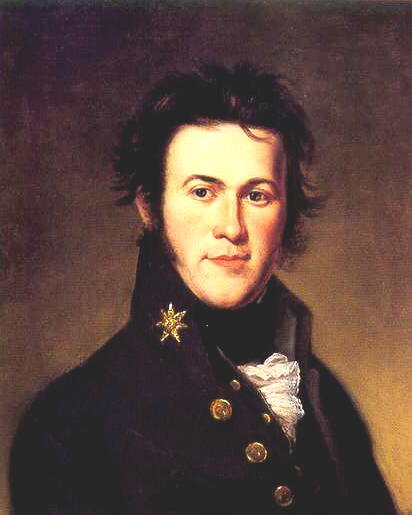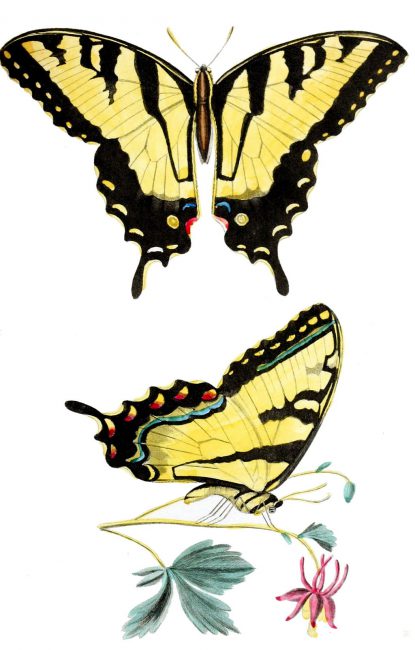
Thomas Say (1787-1834)
On July 27, 1787, American self-taught naturalist, entomologist, malacologist, herpetologist and carcinologist Thomas Say was born. A taxonomist, he is widely considered the father of descriptive entomology in the United States.
Thomas Say – Early Years
Thomas Say was the great-grandson of the co-founder of the American Philosophical Society, John Bartram (1699-1777), and the great-nephew of William Bartram (1739-1823). The whole family consisted of members of a Quaker sect. Say’s statement that he belonged to the Society of Friends, a Quaker sect, led to his expulsion from school. He attended Westtown Boarding School near Philadelphia and his father discouraged him from the pursuit of natural history, trying to interest him instead in the family apothecary business and around 1812, Say even entered into partnership with apothecary John Speakman, but the enterprise failed very soon [2]. His interest in natural history was stimulated by his great-uncle, William Bartram.
The American Natural History Museum
The first American natural history museum was built in Philadelphia. Thousands of insects and other animals are exhibited there, as well as Benjamin Franklin’s (1706-1790) Angora cat and one of the gold pheasants of former US president George Washington (1732-1799). Say was very interested in this museum and spent much of his free time there. In 1812 the pharmacy went bankrupt and Say devoted the rest of his life to his true love, natural history. Since co-founding the Academy of Natural Sciences in Philadelphia in 1812, he had been a member of its charter. He was appointed custodian of the library and collections there; no great task, since at that time the number of exhibits was less than ten native insects, some corals and shells, a dried representative of the frog fish (Batrachoididae) and a stuffed monkey. In 1817 he became a member of the American Philosophical Society. In 1821 Say was employed as a curator at the American Philosophical Society for six years.
Career and Later years
Say served as professor of zoology in the Museum of Philadelphia from 1821 to 1825 [1]. He later left Philadelphia for good and joined the Boatload of Knowledge founded by Robert Owen (1771-1858) and William Maclure, which was based on a cargo boat in New Harmony in the Wabash River and provided a team of scientists. He also became a member of the Utopian Community of Rappites, a German religious sect that developed there. Say secretly married Lucy Way Sistare, a draughtswoman and illustrator of conchology and first female member of the Academy of Natural Sciences, in New Harmony in 1827 and spent the rest of his life there. However, the climate on the Wabash River was very bad for his health, he developed a weak stomach and suffered from dysentery. He was advised to return to his better climate-controlled home, but he did not want to give up the friendships he had made in New Harmony and remained there, where he died on January 4, 1834 of typhoid fever at the age of 47.
Expeditions
During his career, Thomas Say took part in several expeditions. In 1819 – 1820, Major Stephen Harriman Long led an exploration to the Rocky Mountains, which Say accompanied as a zoologist. The expedition party searched for the headwaters of the Red River, made maps of the uncharted Louisiana Territory, and located areas for military posts to protect the American fur trade. Unfortunately, Thomas Say’s journal entries from the expedition were stolen by soldiers, who apparently left the party during the expedition. However, records of the expedition were still published and large collections of the flora and fauna of the area were described. Say himself, collected and described several species including the collared lizard, which is on this day the official state lizard of Oklahoma [1].
Further Expeditions
He took part in another expedition the year after, functioning as zoologist and paleontologist to St. Peter’s River at the headwaters of the Mississippi. The expedition made it all the way up to Lake of the Woods in Canada and across the northern portion of Lake Superior. Say managed to collect enough insect specimens to accurately represent North America in his American Entomology, or Descriptions of the Insects of North America, which was published in three volumes between 1824 and 1828 [2]. Say described over 1500 species of insects. In 1816/17 he published the manuscript Conchology. that was enclosed to the American edition of William Nicholson‘s (1753-1815) British encyclopedia. It was the first paper on native shellfish by an American author.

Papilio glaucus von Thomas Say in American Entomology
The Father of American Entomology
Say’s scientific reputation grew after he published the first volume and he is now considered as the father of American entomology and conchology. After finishing this work, Say went on to publish another definitive work, on American shells, and approached the subject with the same spirit of adventure and reverence that informed his work on insects. As he wrote, “It is an enterprise that may be compared to that of a pioneer or early settler in a strange land,” and he did much to advance Americans’ understanding of the natural world they encountered as they moved inexorably across the continent [3]. Say described over 1500 species of insects. In 1816/17, he published the manuscript Conchology, which was included in the American edition of William Nicholson’s (1753-1815) British encyclopedia. It was the first writing on native shell mollusks by an American author. Say published a three-volume work on American entomology, American entomology or Descriptions of the insects of North America, in 1824-28.
Rick Foster, Centennial Lecture Series: Rick Foster – International Entomology: Changing the World, [13]
References and Further Reading:
- [1] Thomas Say at the Oklahoma State Library
- [2] Thomas Say at the American Philosophical Society
- [3] Thomas Say at the Library of Congress
- [4] Works of Thomas Say in the German Digital Library
- [5] Le Conte, John, ed. (1859). Complete Writings of Thomas Say on the Entomology of North America (two volumes). New York: Bailliere Brothers.
- [6] Mawdsley, Jonathan R. (1993). “The Entomological Collection of Thomas Say”. Psyche. 100 (3–4): 163–171
- [7] Thomas Say (1787–1834), father of American entomology, Indiana University
- [8] Stroud, Patricia Tyson (1992). Thomas Say: New World Naturalist. University of Pennsylvania Press.
- [9] Works by Thomas Say at Project Gutenberg
- [10] Thomas Say at Wikidata
- [11] Timeline of American Entomologists, via Wikidata and DBpedia
- [13] Rick Foster, Centennial Lecture Series: Rick Foster – International Entomology: Changing the World, 2013, Purdue Entomology @ youtube
- [14] Thomas Say at Wikispecies





